Books &Commentary &Puppet Animation &repeated posts 27 Dec 2012 07:28 am
Jason Recapped
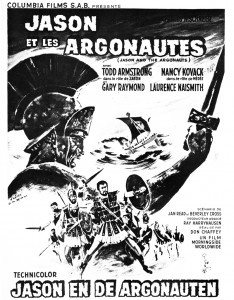
- I’ve thought about stop motion animation recently. Films like ParaNorman are beautifully made oversized spectacles that feel, to me, as if they were trying to mimic cg animation. The quality of the 3D animation has just about moved to the “slick” mode; the work has gotten so well done. This is the ultimate effect of mixing the computer with actual puppets, dolls that the computer creates that are then filmed. Isn’t that what happens with the hundreds of thousands of facial positions that are being created? I have a preference for Tim Burton’s puppet motion in films like Frankenweenie. You can feel the fingerprints on those dolls, unlike the excellent work done on ParaNorman.
I know, I’m complaining about the work being too well done. Too good to satisfy me. I just wonder what Ray Harryhausen would have done in this market. How would his films – rarely on ones, often clunky in its movement – have been accepted by modern audiences? Would audiences balk at that? Or would his extraordinary imagination take the bill and give us plenty to take in?
Last night I went to the movies and saw a lot of 3D action adventure trailers of films coming soon: Jack the Giant Slayer, Oz: The Great and Powerful, even the 3D version of Jurassic Park. There were more of them whose titles I’ve forgotten. They all seem the same – Loud and crushing with all those violent 3D moves. The same whooshing sound effect with every cut. It’s hard to get excited about any of them.
I once posted an article featuring Jason and the Argonauts. There was a chapter from Mr. Harryhausen’s 1972 book, Film Fantasy Scrapbook, about that film. I’d like to show it again. The book is written in the first person singular and collects B&W images like a scrapbook.
Here it is:
Of the 13 fantasy features I have been connected with I think Jason and the Argonauts pleases me the most. It had certain faults, but they are not worth detailing.
Its subject matter formed a natural storyline for the Dynamation medium and like The Seventh Voyage of Sinbad strayed far from the conventional path of the “dinosaur exploitation film” with which this medium seemed to be identified.
Taking about two years to make, it unfortunately came out on the American market near the end of a cycle of Italian-made dubbed epics based loosely on the Greek-Roman legends, which seldom visualized mythology from the purely fantasy point of view. But the exhibitors and the public seem to form a premature judgment based on the title and on the vogue. Again, like Sinbad, the subject brewed in the back of my rnind for years before it reached the light of day through producer Charles Schneer. It turned out to be one of our most expensive productions to date and probably the most lavish. In Great Britain it was among the top ten big money makers of the year.
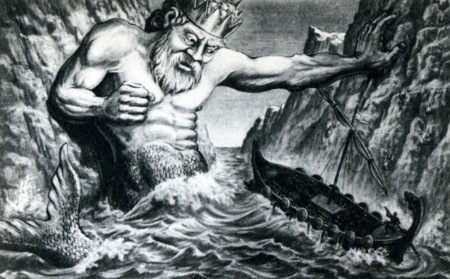
A preproduction drawing (above) compares favorably with a film still (below.)
The drawing is quite a bit more dynamic. (After all, it is Dynamation!)
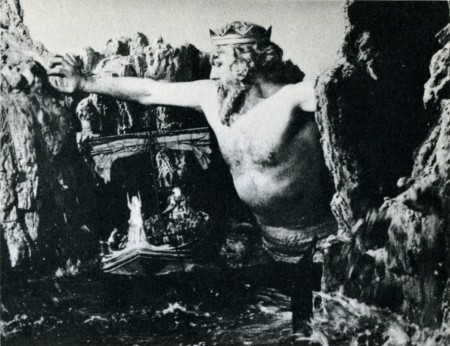
(Click any image to enlarge a bit.)
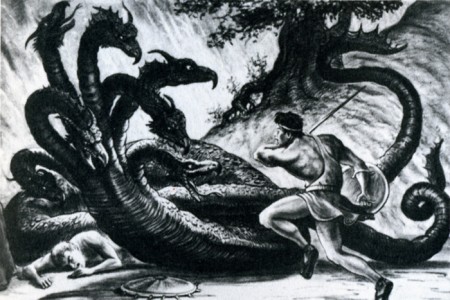
Likewise, a drawing of the hydra (above) film still (below.)
Some of the difference in basic composition between the pre-production sketches I made for Jason and the counterparts frames of the production is the direct result of compromising with available locations.
For example, the ancient temples in Paestum, southern Italy, finally served as the background for the “Harpy” sequence. Originally we were going to build the set when the production was scheduled for Yugoslavia. Wherever possible we try to use an actual location to add to the visual realism. To my mind, most overly designed sets one sees in some fantasy subjects can detract from, rather than add to the final presentation.
Again, it depends on the period in which it is made as well as on the basic subject matter. Korda’s The Thief of Bagdad was the most tastefully produced and designed production of any film of this nature but unfortunately the budget that was required would be prohibitive with today’s costs.
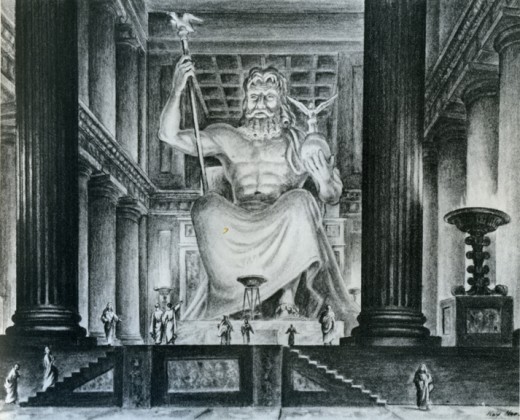
The Skeleton Sequence was the most talked-ahout part of Jason. Technically, it was unprecedented in the sphere of fantasy filming. When one pauses to think that there were seven skeletons fighting three men, with each skeleton having five appendages to move each frame of film, and keeping them all in synchronization with the three actors’ movements, one can readily see why it took four and a half months to record the sequence for the screen.
My one regret is that this section of the picture did not take place at night.
Its effect would have been doubled.
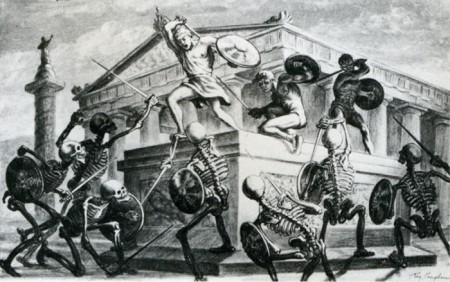
Certain other time-consuming technical “hocus-pocus” adjustments had to be done during shooting to create the illusion of the animated figures in actual contact with the live actors. Bernard Herrmann’s original and suitably fantastic music score wrapped the scenes in an aura of almost nightmarish imagination.
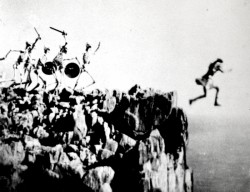
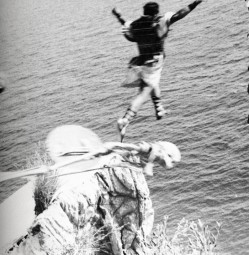
In the story, Jason’s only way of escaping the wild battling sword wielding “children of Hydra’s teeth” is to leap from a cliff into the sea. (Above left) A stuntman, portraying Jason for this shot, leaps from a 90-foot-high platform into the sea closely followed by seven plaster skeletons. It was a dangerous dive and required careful planning and great skill. It becomes an interesting speculation when dealing with skeletons in a film script. How many ways are there of killing off death?
(Above right) Another angle with the real Jason jumping off a wooden platform into a mattress a few feet below. The skeletons and the rocky cliff were put in afterwards while the mattress was blotted out by an overlay of sea.
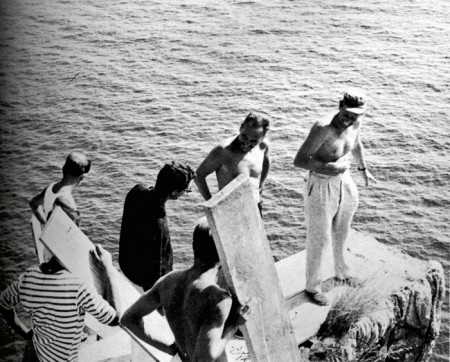
Director Don Chaffey and Ray Harryhausen discuss the leap with Italian stunt director Fernando Poggi.
When transferring published material to the screen it is almost always necessary to take certain liberties in the work in order to present it in the most effective visual terms. Talos, the man of bronze, did exist in Jason legend, although not in the gigantic proportions that we portrayed him in the film. My pattern of thing in designing him on a very large scale stemmed from research on the Colossus of Rhodes.
The actior: his blocking the only entrance to the harbor stimulated many exciting possibilities. Then too, the idea of a gigantic metal statue coming to life has haunted me for years, but without story or situation to bring it to life. It was somewhat ironic when most of my career was spent in trying to perfect smooth and life-like action and in the Talos sequence, the longest animated sequence in the picture, it was necessary to make his movements deliberately stiff and mechanical.
Most of Jason and the Argonauts was shot in and around the little seaside village of Palinuro, just south Naples. The unusual rock formations, the wonderful white sandy beaches, and the natural harbor were within a few miles of each other, making the complete operation convenient and economical. Paestum, w its fine Greek temples, was just a short distance north. All interiors and special sets were photographed in a sm studio in Rome.
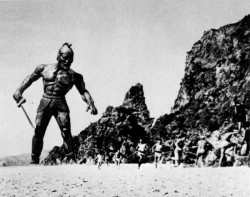
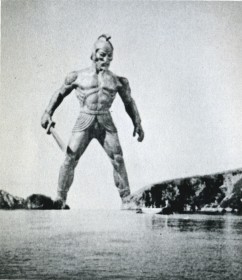 (Above left) Talos, the statue of bronze, pursues Jason’s men.
(Above left) Talos, the statue of bronze, pursues Jason’s men.
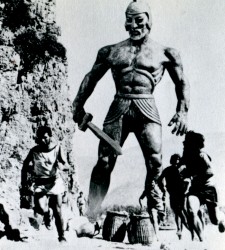
(Above right) Talos blocks the Argo
from the only exit of the bay.
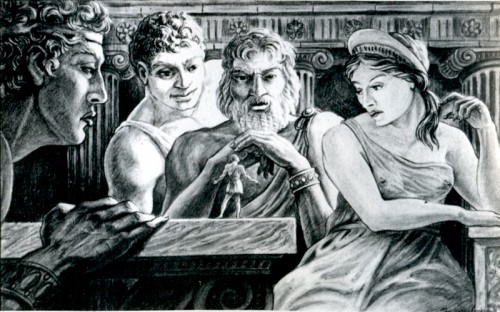
Pre-production drawing of Jason speaking to the Gods of Greece.
For the second unit operation a special platform had to be fitted to the Argo in order to achieve certain camera angles. Although it looks precarious it was far more convenient than using another boat for the shots.
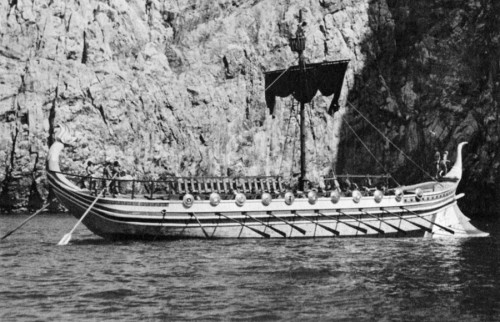
The Argo had to be, above all, practical in the sense that it must be seaworthy as well as impressive. It was specially constructed for the film over the existing framework of a fishing barge. There were twin engines for speed in maneuvering, which also made the ship easily manipulated into proper sunlight for each new set-up.
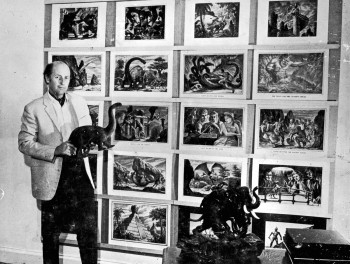
Harryhausen off the book’s back cover
to give an idea of scale of drawing sizes.
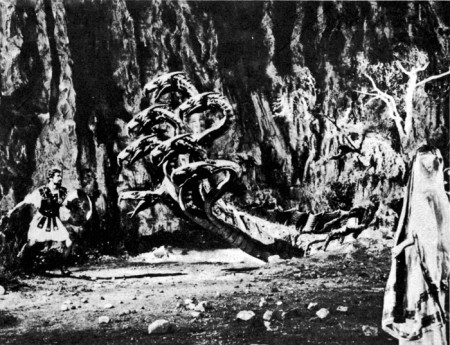
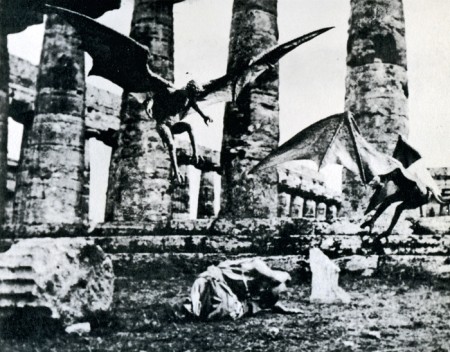
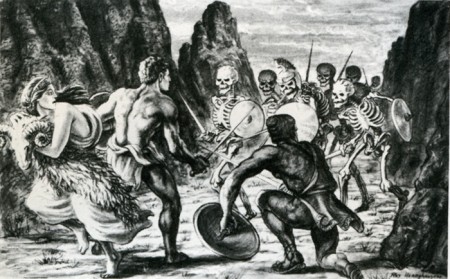
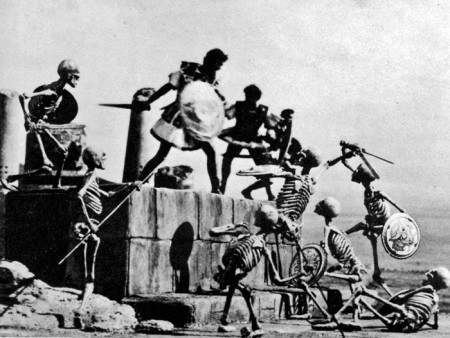
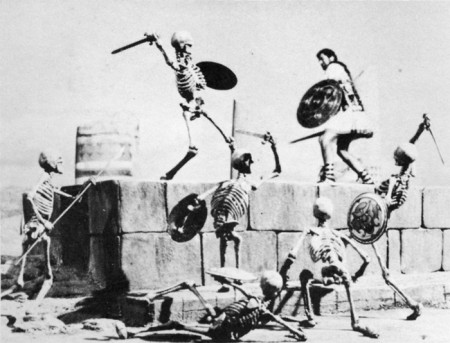
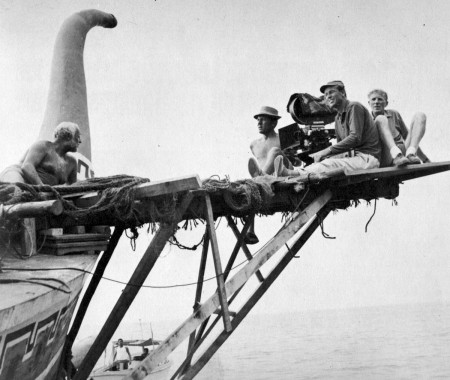

on 27 Dec 2012 at 10:58 am 1.Richard O'Connor said …
Fantastic article. This film is not simply an effects marvel, but also a tightly scripted philosophical treatise. I wonder if I would be the atheist I am today without Jason’s strident distain and complex relations with the gods.
Mr. Harryhausen’s point about “overly designed sets” should be pinned to the walls of every sword and sandal/fantasy/sci-fi production designer in Hollywood (and New Zealand, for that matter).
on 27 Dec 2012 at 6:11 pm 2.Elliot Cowan said …
I’m a big fan of Paranorman.
Although the animation is incredibly slick, I’m tempted to ask why more CG films don’t look like this rather than comparing it to CG.
on 27 Dec 2012 at 7:01 pm 3.the Gee said …
Well, if the goal is too be more “realistic†and/or cinematic in the look of CG animation then isn’t expecting faking or emulating a crudeness that is found in stuff like this stop-mo animation something which that modern CG animation would avoid?
I don’t know if that is a good question to ask.
In considering it, sometimes some people do want their photographs to look like they were taken on old polaroid cameras.
It would almost seem like emulating effects like in “Jason†would only be done for parts of a production, say, if a 1940s black and white newsreel or a 1950s monster movie were part of a longer feature film. If it were used, it would be used sparingly and for –pardon the pun–effect.
(this is a so-so day and what I wrote isn’t adding anything to this topic, sorry)
on 27 Dec 2012 at 8:12 pm 4.Andrew said …
Hmmm, how would Harryhausen films be received by today’s public? There’s a good chance that the public might balk at them because of their crudeness. How else would you explain the fact that all of the stop motion films this year were outperformed in the box office by the CG films? Take me for example. When I was a high school student, I looked up the original King Kong for the first time after watching the 2005 remake. I was put off by the clips of the original film because the stop motion models of Kong and the dinosaurs were so obvious and their movements were so crude. I had long been used to the slick CG productions that I had forgotten the raw techniques to make films like the classic King Kong and Jason and the Argonauts. I wonder if the public today is like that. There seems to be a certain bias against stop motion animation. There is a reason why films like Coraline and ParaNorman’s animation is very slick. When I first watched Coraline, I was confused at the first minute if it was CG or stop motion because the animation was so smooth (I figured out that it was stop motion few minutes later). After the film, I asked my friend who watched with me if he thought it was CG or stop motion, and he actually didn’t know(!)
As for the original King Kong, I watched it recently in its entirety and I must say that I appreciate it now more than ever. The special effects are incredible considering the time period and contain a lot of charm and imagination, especially in the stop motion effects of Kong and the dinosaurs. By the end of the film, I was able to believe in Kong as a character, not just a crude puppet.
on 27 Dec 2012 at 9:05 pm 5.the Gee said …
To add to that, some friends and I saw “Luxo, Jr†years ago and they were convinced it was stop motion. I remember being frustrated and tried to explain to them that it wasn’t stop mo.
I hadn’t considered how it would look if someone were accustomed to slicker, seamless motion.
As a kid, “Jason and the Argonauts†and those skeletons in it were amazing. Even then, I knew it wasn’t real but the fact that they looked like they shouldn’t be moving and were was amazing.
There was also a sense that they were easily defeatable because of their herky jerky motion. But, those suckers kept fighting and closing in.
There was this stop-mo animation in (i think) it was the movie “Night Galleryâ€. A little voodoo doll that came to life and tried to kill the woman who bought it.
The fact that it was a doll and shown as immobile made it all that much more terrifying to see it get up and run around hacking at a bathroom door! It looked like it belonged, but, that *was* on a B/W TV. It looked real enough to a little kid.
So, if we are too sophisticated, too astute or just used to seeing something very real then maybe the uncanny valley has changed over the years? Or, at least what we accept and reject as plausible.
(again, hope that makes enough sense)
on 14 Jun 2014 at 4:41 pm 6.http://www.healthgrades.com/physician/dr-jason-hope-blasz said …
Good day! I simply would like to offer you a big thumbs up for the excellent info you’ve got here on this post.
I am coming back to your website for more soon.